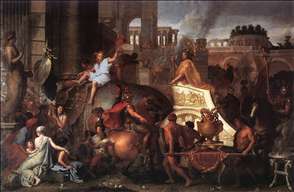French painter and art theorist, the dominant artist of Louis XIV s reign. After training with
Vouet he went to Rome in 1642 and worked under
Poussin, becoming a convert to the latter s theories of art. He returned to Paris in 1646. In 1662 he was raised to nobility and named Premier Peintre du roi , and in 1663 he was made director of the reorganized Gobelins factory. Also in 1663 he was made director of the reorganized Acadmie, which he turned into a channel for imposing a codified system of orthodoxy in matters of art. His lectures came to be accepted as providing the official standards of artistic correctness and, formulated on the basis of the classicism of
Poussin, gave authority to the view that every aspect of artistic creation can be reduced to teachable rule and precept. In 1698 his small illustrated treatise Mthode pour apprendre dessiner les passions was posthumously published; in this, again, following theories of
Poussin, he purported to codify the visual expression of the emotions in painting.
Despite the classicism of his theories, Le Brun s own talents lay rather in the direction of flamboyant and grandiose decorative effects. Among the most outstanding of his works for the king were the Galerie d Apollon at the Louvre (1663), and the famous
Galerie des Glaces (1679-84) and the Great Staircase (1671-78, destroyed in 1752) at Versailles.
His importance in the history of French art is twofold: his contributions to the magnificence of the Grand Manner of Louis XIV and his influence in laying the basis of academicism. Many of the leading French artists of the next generation trained in his studio. Le Brun was a fine portraitist and an extremely prolific draughtsman.









